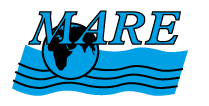A program of the Lawrence Hall of Science that seeks to increase ocean literacy through informal and formal education initiatives
The Atlas of Oceans
The Atlas Of Oceans is a superbly presented guide to the world's oceans and covers how they work and where they are in the world, from currents and waves to different depths and attempts to explore the world's oceans. Geography and science classes will find The Atlas Of Oceans very useful for the elementary grade students with its many photos and an alluring narrative structure.
Extremely Weird Fishes
A survey of unusual fishes that serves up some titilating tidbits of information. Double-page treatments cover 21 different species, offering a brief description of the outstanding physical characteristics or habits that make each unique and a sharp, full-page, color photo. In most cases only the face of the fish is visible. The majority of the species are found in tropical waters, but some cold water creatures are included. All are identified by scientific as well as common names. Blocks of small print present miscellaneous ichthyological facts, accompanied by one or two small cartoons.
Rubbery Arms and Baggy Bodies
There are many different kinds of octopus. Read about their different sizes, their bodies, homes, what they eat, and the 150,000 eggs that the females can lay. Find out how octopus move by squirting water to propel themselves, how smart they are, and how they escape from their enemies. Then learn how to write a report.
The Lorax
When Dr. Seuss gets serious, you know it must be important. Published in 1971, and perhaps inspired by the "save our planet" mindset of the 1960s, The Lorax is an ecological warning that still rings true today amidst the dangers of clear-cutting, pollution, and disregard for the earth's environment. In The Lorax, we find what we've come to expect from the illustrious doctor: brilliantly whimsical rhymes, delightfully original creatures, and weirdly undulating illustrations.
Bill Nye the Science Guy's Big Blue Ocean
Make a tsunami in your bathtub! OK, so it’s only a little tsunami, but it’s still a fun way to learn about the ocean and sea life. Witty Bill Nye helps children explore marine biology through lively descriptions, silly pictures, and offbeat experiments to try at home or school with basketballs, balloons, and squid (or a reasonable facsimile).
Coral Reefs
Dr. Sylvia Earle, marine biologist and oceans ambassador extraordinaire is the author of this colorful picture book on coral reefs. The reading level and illustrations are low for seventh graders, but the book is packed with outstanding factual information, a fun at-home experiment, and lovely illustrations.
Invertebrates
This is a current survey of the 34 animal phyla and serves as both a college course text and an excellent reference on invertebrate biology. It is organized around the themes of body plans and evolution (phylogenetics).
In the Swim
"There are uglier fish than a blenny-- But not many..." That's just the start of one of 21 creative and imaginative poems focusing on a variety of ocean creatures. A fantastic literature and poetry connection accompanied with whimsical water-colored illustrations makes this a good read out-loud or student reader.
Marine and Estuarine Ecology
This book is written at a high school level, but can be used as a reference by teachers in a number of habitats.
A high school textbook and workbook introducing marine and estuarine ecology, marine habitats, and the diversity of marine animals and plants.
Earth: The Water Planet
Designed for middle-level Earth science teachers, Earth: The Water Planet explains how to use readily available materials and a variety of instructional methods to investigate how water shapes our planet and daily lives. Included are hands-on experiments challenging you to purify swamp-water, conservation-oriented activities showing how much water is wasted by a dripping faucet, and a role-playing activity in which students present opposing arguments at a town meeting.
Pages




